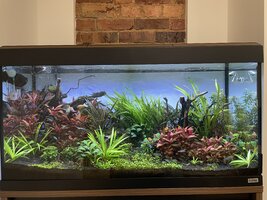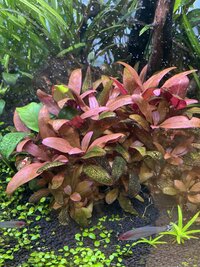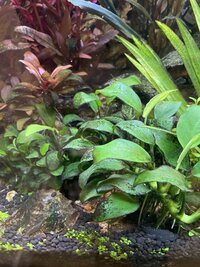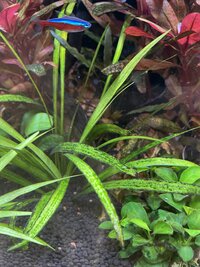Yes... the water flow is very dependent on the design of the power head. The bottom line is that the actual movement and flow of water is rarely what one is expecting... otherwise it would be too easy to get good circulation 😉Hi Arcturus,
These Kh and Gh values are from my test (API Test kit). About the diffuser, I moved it below the power head but the result is not what you expect 🙂 The bubbles are going behind the power head straight to the top. I have to stick the diffuser to the front glass in order to work. It doesn't look good but i will leave it for now just to test.
-
You are viewing the forum as a Guest, please login (you can use your Facebook, Twitter, Google or Microsoft account to login) or register using this link: Log in or Sign Up
You are using an out of date browser. It may not display this or other websites correctly.
You should upgrade or use an alternative browser.
You should upgrade or use an alternative browser.
Plants turning black
- Thread starter D.Bezinski
- Start date
Hi @D.BezinskiI am new to the hobby and need help identifying the type of algae I am dealing with...
It looks very much like Black Beard Algae (Audouinella), usually abbreviated to 'BBA'. I've often found the following to be a useful starting point:

I also hope you find it useful.
JPC
MichaelJ
Member
Hi @D.Bezinski Black Beard Algae (BBA)... Looks like a classic CO2 issue to me. Is this DIY CO2 like a yeast based system? Those are prone to inconsistent delivery causing fluctuating CO2 levels.... a standing invitation to BBA. Your best bet is to dial down the light intensity (not hours/photoperiod), increase your water change frequency and/or % amount and improve your flow/circulation. WRT water parameters, the things that sticks out is the low PO4 levels - I would bump that to 4-5 ppm. I would supplement your Tropica Premium with some Phosphate (which your not getting with Premium) and possibly Potassium (which is too low with Premium) and Mg if your in the parts of the UK where there are very little Mg in the water. To error on the safe side with NO3 you could supplement with Nitrogen (your also not getting any NO3 with Tropica Premium), say 12ppm/wk. which will bring you into the 15-40ppm range based on the tap reports 3-28ppm. range.
You can also spot treat the Anubias with Carbo, brushing it onto the leaves and let it dry for a couple of minutes - just make sure you don't get carbo into the rhizome or roots as that will kill the plant. Dosing Carbo to combat BBA seems to be a hit and miss... You have to go all-in on all the above. BBA is very persistent, so it may take a while before seeing improvements.
As for the hard water; personally I would aim for softer water for the livestock, not the plants (I don't see any plants there that require soft water), but its not essential.
Welcome to UKAPS 🙂
Cheers,
Michael
You can also spot treat the Anubias with Carbo, brushing it onto the leaves and let it dry for a couple of minutes - just make sure you don't get carbo into the rhizome or roots as that will kill the plant. Dosing Carbo to combat BBA seems to be a hit and miss... You have to go all-in on all the above. BBA is very persistent, so it may take a while before seeing improvements.
As for the hard water; personally I would aim for softer water for the livestock, not the plants (I don't see any plants there that require soft water), but its not essential.
Welcome to UKAPS 🙂
Cheers,
Michael
Last edited:
Thank you JPC. I will have a look.Hi @D.Bezinski
It looks very much like Black Beard Algae (Audouinella), usually abbreviated to 'BBA'. I've often found the following to be a useful starting point:

I also hope you find it useful.
JPC
Hi Michael,Hi @D.Bezinski Black Beard Algae (BBA)... Looks like a classic CO2 issue to me. Is this DIY CO2 like a yeast based system? Those are prone to inconsistent delivery causing fluctuating CO2 levels.... a standing invitation to BBA. Your best bet is to dial down the light intensity (not hours/photoperiod), increase your water change frequency and/or % amount and improve your flow/circulation. WRT water parameters, the things that sticks out is the low PO4 levels - I would bump that to 4-5 ppm. I would supplement your Tropica Premium with some Phosphate (which your not getting with Premium) and possibly Potassium (which is too low with Premium) and Mg if your in the parts of the UK where there are very little Mg in the water. To error on the safe side with NO3 you could supplement with Nitrogen (your also not getting any NO3 with Tropica Premium), say 12ppm/wk. which will bring you into the 15-40ppm range based on the tap reports 3-28ppm. range.
You can also spot treat the Anubias with Carbo, brushing it onto the leaves and let it dry for a couple of minutes - just make sure you don't get carbo into the rhizome or roots as that will kill the plant. Dosing Carbo to combat BBA seems to be a hit and miss... You have to go all-in on all the above. BBA is very persistent, so it may take a while before seeing improvements.
As for the hard water; personally I would aim for softer water for the livestock, not the plants (I don't see any plants there that require soft water), but its not essential.
Welcome to UKAPS 🙂
Cheers,
Michael
Thanks for the advise 🙂 I already started with some changes and now i just have to wait and observe 🙂
I'm with MichaelJ when it comes to water changes. I do a 60% water change weekly
Apart from getting rid of dissolved waste, water changes also gives you an opportunity to vacuum your substrate to remove detritus, rotting leaf fragments that got trapped in the substrate, etc.
My experience is that BBA often appears on slow growing plants. My Bucephelandra at the side of the tank next to the CO2 diffuser have small amounts of BBA which I have to treat. (some articles like in 2hr Aquarist mention a correlation between BBA and slowgrowing plants in the path of strong CO2 mist).
Apart from getting rid of dissolved waste, water changes also gives you an opportunity to vacuum your substrate to remove detritus, rotting leaf fragments that got trapped in the substrate, etc.
My experience is that BBA often appears on slow growing plants. My Bucephelandra at the side of the tank next to the CO2 diffuser have small amounts of BBA which I have to treat. (some articles like in 2hr Aquarist mention a correlation between BBA and slowgrowing plants in the path of strong CO2 mist).
MichaelJ
Member
That one as well! In addition, I usually take the opportunity during WCs to trim plants as well (and get rid of duckweed 🙂 ) just makes the whole thing much easier.Apart from getting rid of dissolved waste, water changes also gives you an opportunity to vacuum your substrate to remove detritus, rotting leaf fragments that got trapped in the substrate, etc.
Cheers,
Michael
Last edited:
Hi all,
Big discussion 🙂 bottom line is:
I've moved the diffuser underneath the power head, increased the co2 bubbles and set the light to 60%. Also, i am dosing (using a bottle from a tropica fertilizer) 5 pumps Cabro and 3 pumps Tropica Specialised daily. I hope i am going in the right direction.
About my inhabitants, i was thinking of adding more color (some ember tetras) but i want to sort out the algae issue first 🙂
Big discussion 🙂 bottom line is:
I've moved the diffuser underneath the power head, increased the co2 bubbles and set the light to 60%. Also, i am dosing (using a bottle from a tropica fertilizer) 5 pumps Cabro and 3 pumps Tropica Specialised daily. I hope i am going in the right direction.
About my inhabitants, i was thinking of adding more color (some ember tetras) but i want to sort out the algae issue first 🙂
MichaelJ
Member
Hi @D.Bezinski You bet. That's what we love here...as long as its fruitful and civil 🙂Hi all,
Big discussion 🙂
You might want to look into doing a pH Profile. I suggest posting in the CO2 section to ask for more details on that - including as much details about your CO2 setup and a full tank shot.bottom line is:
I've moved the diffuser underneath the power head, increased the co2 bubbles and set the light to 60%. Also, i am dosing (using a bottle from a tropica fertilizer) 5 pumps Cabro and 3 pumps Tropica Specialised daily. I hope i am going in the right direction.
Embers are lovely nano tetras - I have a small school myself. If alone, they have a tendency to be a bit shy, but they will get along well with your cardinals and rummy's.About my inhabitants, i was thinking of adding more color (some ember tetras) but i want to sort out the algae issue first 🙂
Cheers,
Michael
Hi @MichaelJPhotoperiod matters much less than light intensity. Light intensity regulates the plants immediate metabolic rate and need for immediate nutrients predominantly CO2. I do not inject CO2 so I run my lights at very low intensity levels, but for long hours (12 hours to be exact - consistent with the daylight around the equator where most our plants are from...) and I have zero algae to speak of.
That's very interesting! @Christel is an advocate of mimicking nature with a 12 hour photoperiod and she knows a thing or two about cultivating aquatic plants. When you say "Light intensity regulates the plants immediate metabolic rate and need for immediate nutrients predominantly CO2", I think of light as the conductor of an orchestra. Excluding the composer for a moment, it's the conductor who dictates the pace of the music. OK, that may not be the best analogy so please don't cringe at the thought!
JPC
Hi @D.BezinskiAbout my inhabitants, i was thinking of adding more color (some ember tetras) but i want to sort out the algae issue first 🙂
Very wise. As the saying goes, "Patience is a virtue" and in aquatics, it speaks volumes.
JPC
Its for sure counterintuitive that low tech asks for less water changes and high tech requires more work not less. 👨🎓 Always learning.
I guess that's why George Farmer and some others prefer the term "low energy" and "high energy".
Using a TDS meter, I find that the daily increase in TDS in my 'high energy' tank is greater than the increase in TDS in my 'low energy' tank, which might therefore support the need for high energy tanks to have more frequent water changes.
MichaelJ
Member
Hi @jaypeecee,
Cheers,
Michael
That's for sure and makes total sense. Besides the photoperiod consideration, given our plants natural habitats around the equator and all that, I want to enjoy my tanks when I feel like it and not having to be on the clock for a limited show time... The lights in my tanks ramps up just before noon and ramps down at midnight (the family room where the tanks sits is fairly dark during the day - in part to be able to enjoy the tanks). Sometimes during the weekend I overrule the timer and let it run for an additional hour or so.
I think that is a good analogy actually.When you say "Light intensity regulates the plants immediate metabolic rate and need for immediate nutrients predominantly CO2", I think of light as the conductor of an orchestra. Excluding the composer for a moment, it's the conductor who dictates the pace of the music. OK, that may not be the best analogy so please don't cringe at the thought!
Cheers,
Michael
Last edited:
MichaelJ
Member
Hi @erwin123 ,
Cheers,
Michael
Yes, Higher energy equals higher overall plant metabolism and more waste creation.I guess that's why George Farmer and some others prefer the term "low energy" and "high energy".
That is essentially how I gauge if my weekly maintenance is up to par as well - if I start to see TDS creep I know I might have to take some corrective actions such as upping my weekly WC% It's really like an early warning - like taking the tanks blood pressure 🙂Using a TDS meter, I find that the daily increase in TDS in my 'high energy' tank is greater than the increase in TDS in my 'low energy' tank, which might therefore support the need for high energy tanks to have more frequent water changes.
Cheers,
Michael
Last edited:
kayjo
Member
MichaelJ, I found this interesting. You may as well. Source is The Barr ReportPhotoperiod matters much less than light intensity. Light intensity regulates the plants immediate metabolic rate and need for immediate nutrients predominantly CO2. I do not inject CO2 so I run my lights at very low intensity levels, but for long hours (12 hours to be exact - consistent with the daylight around the equator where most our plants are from...) and I have zero algae to speak of.
For most aquatic plants, the LCP (minimum light level needed for survival) is somewhere around 10-50 µmol.m-2.s-1, the Km (half-saturation constant were growth rate is 50%) is somewhere around 100 µmol.m-2.s-1, and the LS (maximum usable light level) is somewhere around 600-700 µmol.m-2.s-1.
From the above data you can clearly see that for most aquatic plants the optimum (maximum usable) light level is around 600-700 µmol PAR, which is way too high to use in our tanks. The minimum light level at which plants begin to increase their biomass is around 10-50 µmol PAR which is the value usually recommended here (10-30 µmol PAR for undemanding low-light plants, and 50 µmol PAR for demanding high-light plants). This is the recommended minimum for them to grow. If you were to ensure them at least 50% growth rates, you should give them at least 100 µmol PAR. Also, don't forget that the light intensity decreases with the distance from the light source. So if you have 50 µmol PAR at the bottom of your tank, at the water surface you may have 200-300 µmol PAR. So while at the bottom you may have the minimum light level for plants to grow, at the surface they'll be bombarded by quite high light levels. So although it is true that for most aquatic plants the values around 600-700 µmol PAR would be best, under such a high light levels your algae will grow like mad. So in our tanks we have to find out some compromise for plants to grow well, but for algae to not have enough light to cause us problems. That's the reason why most wise people recommend to use no more than 80-100 µmol PAR at the bottom (at substrate level).
Hi All,
Little update. Please see the pictures attached.
Currently the light is set to 60% intensity, 30 min sunrise, 30 min sunset, total hours on - 8h. CO2 - 4 bubbles per second. I've changed the fertilizer to TNC Lite dosing daily 4ml. By doing this the nitrates are now 20ppm. I've tried increasing the phosphates by dosing easy life fosfo and i was keeping it between 1-2ppm. I don't know if this is too high or too low.
Do you have any other ideas about how to get rid of the green spot algae?
Thank you.
Little update. Please see the pictures attached.
Currently the light is set to 60% intensity, 30 min sunrise, 30 min sunset, total hours on - 8h. CO2 - 4 bubbles per second. I've changed the fertilizer to TNC Lite dosing daily 4ml. By doing this the nitrates are now 20ppm. I've tried increasing the phosphates by dosing easy life fosfo and i was keeping it between 1-2ppm. I don't know if this is too high or too low.
Do you have any other ideas about how to get rid of the green spot algae?
Thank you.






